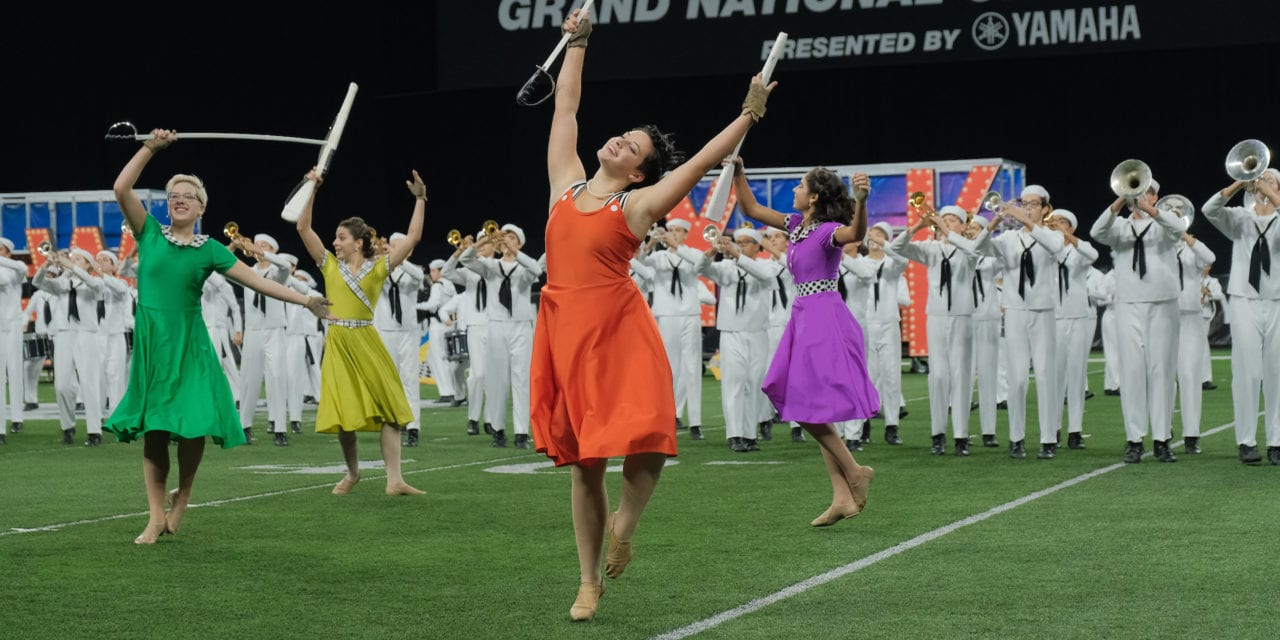By Gary Markham
“General Effect” is the most subjective and mercurial of all aspects of marching band performance and adjudication. The debate about various aspects of General Effect is continual in any adjudication system that takes General Effect into consideration.
In the Bands of America marching band adjudication system, 60% of the total score is allotted for General Effect (40% for performance… likewise, 60% of the total score is allotted for Music, 40% for Visual).
Following work by BOA’s Chief Judge and a committee of participating directors that met in June, the Bands of America Music General Effect and Visual General Effect judging sheets were revised to serve as a better tool for evaluation. It is important to realize that the philosophical approach to each of these captions has not changed, but the design has been changed to focus each of the sheets on their original intent. A committee of the BOA’s advisory board met to discuss and revise the sheets at the BOA Summer Symposium, with input from additional participating directors. It was felt that the Music GE sheet in particular contained phrases that were not directly music specific, therefore, more appropriate phrasing was developed.
It is a challenge even for seasoned judges to verbalize what General Effect is, so it is not surprising that it remains unclear for many directors. Let’s look at General Effect from your viewpoint as band director and from the vantage point of the adjudicator.
The Conception Stage
Mindful listening is perhaps the most complex and challenging act of human cognition. It requires high levels of perceptual acuity. “Meaning” requires that the mind construct the relationships among the sounds of which music is made and portray those sounds visually. You must feel those relationships subjectively and sensuously if meaning is to be grasped. Musical sound relationships always exist in a historically and culturally derived framework.
Enormously diverse, culturally derived, historically situated, imaginatively conceived, affectively ladened sound complexes (the music) must be kept in memory at many levels of operation:
- Immediate remembrance of sounds as they are being heard
- How they interrelate over the course of time
- How it is similar to or different from others in terms of genre, style, cultural and historical matrix
Try to close the gap between what is potentially meaningful listening engagement and what is actually grasped in that engagement. After all, the music being heard is often the result of intensive labor on the part of composers, arrangers, and performers at the highest levels of artistic listening.
Several points are important to keep in mind for the designer’s conception, the teacher’s communication, the students’ understanding and performance and the audience’s appreciation–intellectually, emotionally and aesthetically:
- The Designer creates the program plan, selects the music, plans the effects, stages and coordinates the show, envisions the concept–the master plan of the show.
- The Teacher communicates the understanding, technique, and motivation for the students.
- The Performers bring the show to life.
- The Judge responds, rewarding the designer, teacher, and performer through the GE scoresheet.
Crediting General Effect
Adjudicators strive to credit all of the musical/visual elements in the band’s presentation that combine to display an effective and entertaining program.We credit the successful communication of the band’s identity and message through the tasteful blend of creativity and performance, as well as the performer’s ability to connect with the audience.
Design Considerations
The music gives motivation to the visual design in creating an effective presentation. The musical selections create the mood and guide the feelings and responses of the audience while observing the show. Do not lose sight of the impact that music choices will have on the audience. These choices will contribute to the connection and entertainment value that is made to the audience. These musical choices and the arrangements will suggest how, when, and where visual elements will be utilized.
Realization of the Visual Design — Driven by the Music
Programs can tell a story, be an emotional experience of the music, be written around a particular style, or in any combination. The quality of the musical composition becomes the basis for the visual delivery and will guide the visual designer in orchestrating and arranging the visual presentation — the depth to which these elements are coordinated, staged, and presented becomes an important factor in the General Effect Visual evaluation and comparison.
There are three approaches to creating effect:
- The intellectual aspect of effect is reflected in the range and quality of the visual plan.
- The emotional effect is the planned response to the audio/visual presentation that is designed, coordinated and staged for the purpose of evoking a specific, planned reaction.
- The aesthetic aspect of effect involves the beauty, artistry, and detailing of the presentation.
Toward creating effect, these may be presented individually or in combination – the use of two or three create variety — the simultaneous fusion of all three offers the strongest effect potential.
It is important to stress that great effect depends on the quality, development, range, and detailing of the program design.Consider the following important aspects of successful General Effect: When, Where, How, Why. How you create the effect:
- Pacing: the when factor of planned effects–How close, how often, how large?
- Continuity: the development, connection, and evolution of planned effects
- Staging: where each effect is placed on the field
- Coordination: how all elements work together to enhance effect
- Impacts: the beginning of important musical/ visual ideas
- Resolutions: The completion of important musical/ visual ideas.
The synthesis and depth of the music and the visual blending is a critical factor in the success of a program. How, when and where these effects develop, the designed pathways and placement on the field, the evolution of idea to idea, the many levels of musicality, and how each element works with others, are inherent aspects in the quality and range of the program design, and will elevate the effects beyond isolated moments.
Creativity and originality are significant factors in General Effect evaluation. Is the effect: Creation? Imitation? Repetition?
Is the effect: Cliché or Fresh Idea? Trite or Original? Usual or Exceptional? Replication or Innovation? Tradition or New Form? Imitation or Creation?
Bringing the Show to Life — The Performers
After the show has been designed, it is up to the teachers and performers to “bring the show to life” through performance.
Aspects of Showmanship:
- Communication: understanding and commitment to the musical/ visual performance
- Identity/Character: the demonstration of meaning through musical and visual display
- Musical and Visual Techniques
- Excellence
Teachers must be able to convey to students the understanding, passion, and emotional elements of a program, and give them the necessary technique tools. These qualities must transcend the purely technical aspect of performance. These qualities of performance bring the audience in to share the experience. Teachers and designers must provide the necessary opportunities to demonstrate these communication skills. It is more than just energy and enthusiasm. Obviously, pure excellence is often an effect of its own and great programming with poor technique has a negative effect. However, technical excellence is only one ingredient necessary for maximum effect. A quality program only exists if it is performed and understood.
Audience Accessibility
Audiences expect a captivating quality performance. It is the blending of a quality program and quality performance that creates the necessary effect for our audience. The quality of the performance, the depth of the training, and the communication of the performers, creates the connection to the audience and judge who respond to them with admiration, appreciation, and scoring. Avoid trying to educate an audience at a level they will not achieve. Always consider the audience along with what students should know and be able to do from a programming standpoint.
Judging the Performance
All of the above must be considered in the judge’s evaluation of a performance – the judge is evaluating the effectiveness of repertoire, showmanship and coordination. We should strive to be clear that the judge, in the broadest sense, is measuring the entertainment value of the program and not the judge’s life experiences.
- Is the audience engaged?
- Are there climaxes?
- Is there good pacing?
- Is there tension and release?
- Is there variety?
- Are there breaks in continuity?
- Is the pacing and interest maintained?
For adjudicators, the primary premise of general effect judging is that you must prepare mentally to allow yourself to be entertained! As adjudicators, we are part of the audience, a widely experienced and critical part of the audience to be sure, but nonetheless, there to enjoy the performance. We each have our preferences, whether they be in choice of music program, manner of presentation, or style of interpretation. Our goal, to be effective as a judge in this area, is to allow ourselves to appreciate what is good about a given production based on what is being presented.
We have to sometimes remove ourselves from our own tastes and opinions to recognize and appreciate the approach others are attempting to use to reach the audience. It is important for us to realize that entertainment can take many forms. Comedy, drama, pathos… the entire range of emotion should be considered as being valuable in programming. A show that successfully touches the audience emotionally on the deeper side of the scale should receive equal consideration with programs that consist primarily of qualities that make us feel good.
We must ascertain as to whether the selected approach by the programmer, as performed by the students, is viable, using our best judgment based on our experience. If it does work, we should supply comment to that effect with suggestions to maximize the potential of the production. If the production falls short, it is important and necessary to supply information as to why it is not effective. Beyond the repair comment, we need to aid the programmer in avoiding problems in the future. This is often a matter of his matching material to student abilities as well as communicating sufficient information to the performers to allow them to perform in a more effective manner.
Our attitude and mental preparation should be such that we are anticipating a well-performed program and that we are looking for what the performers are doing well. This does not mean that we ignore those portions of the program that are not well prepared or performed, but rather, after having made comment on the deficient segment with suggestions for improvement, we immediately look once again for the positive qualities of the performance. This creates a considerably brighter outlook on the part of the judge (also reducing the wear of the work load somewhat) and results in tapes that can be very helpful and fulfilling to both the director and the students. If we can come across as wanting to be helpful, recognizing the strengths as well as the weaknesses, we stand a much better chance of actually communicating and thereby being much more effective judges.
The influence of audience reaction on your impression of program effectiveness should be tempered by the interpretation of it being a genuine response to excellence of performance rather than the efforts of hometown supporters. A genuine audience reaction to something that left you unimpressed personally warrants credit, for it has achieved effect. However, do not be at all reticent to credit productions that you find to be worthwhile and well done, even though the reaction of the general audience may be cool.
The underlying thesis here is: credit that which is well prepared, is performed with excellence and evokes an emotional response.



